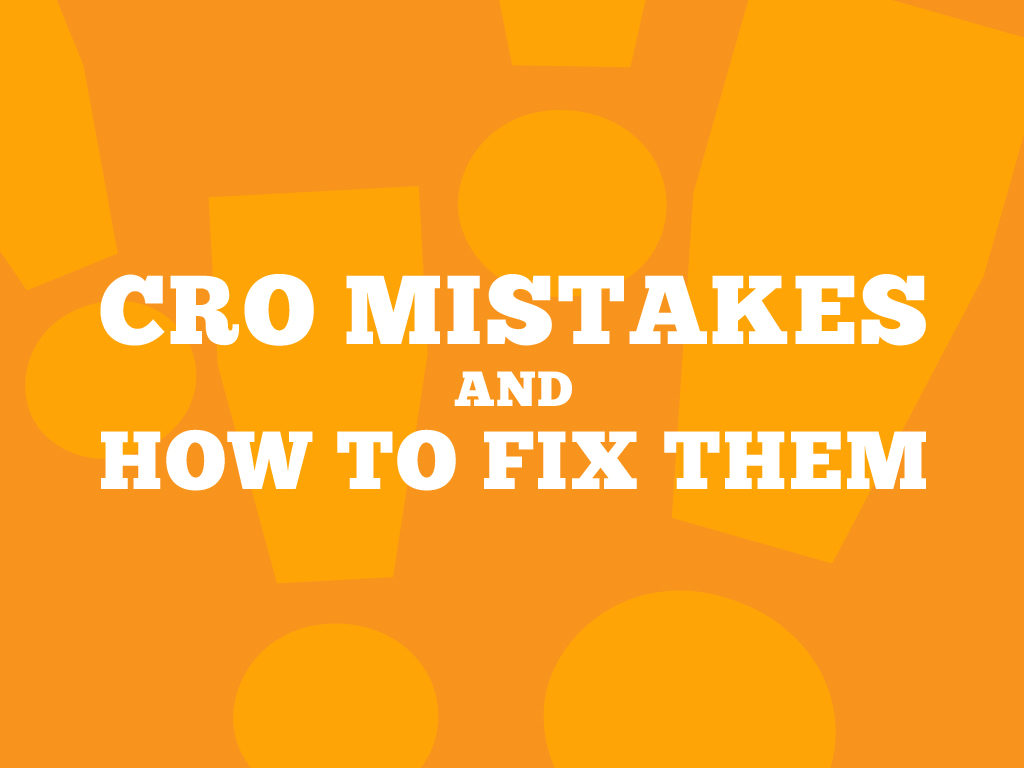5 CRO Mistakes That Need to Be Fixed!
Much like your link building campaign or the process of your keyword research, CRO should also be on the top list of your priorities. Without the proper enactment of CRO into your SEO, your rate of converting visitors into customers would be mediocre – to say the least. So, this only highlights the importance of CRO for every business or brand that has an online presence.
It is common knowledge that Conversion Rate Optimization is a system that most – if not all – webmasters of business websites use to increase the percentage of visitors converted into a customer. However, this process is still susceptible to errors and mistakes that can damage your SEO campaign. Today, I’ll be giving out some tips which have always worked for me whenever I encountered some problems in my CRO endeavors.
Here’s a scenario: You test a redesign through A/B testing – which would mean that half of your visitors could see the original design of your page, and the other half would see the new redesign that you worked on.
Then, after a month or so, you notice that the demo requests increased from 4% to 15%. This means good news for you and your company. So, you immediately report to the boss that your new redesign works, and they give you the go sign.
However, after you have introduced the new redesign, the requests suddenly decrease. So, you assume that it is about the seasonal changes in the consumer’s tastes, and you wait a few months to see if it would go improve. Then, your monthly recurring revenue is also decreasing, so what’s wrong?
The Mistake
It so happens that the length of time of your test was not long enough for the results to be significant. The page you used in the test only received an average of 60 views per day, but the optimal number would have been over a hundred thousand for it to have an over 90% confidence level. So, because of the mistake, the company is losing important business.
This is just one of the mistakes you can make in your CRO. It is actually understandable because numerous marketers THINK that they are leading their company to something great, but in reality, they are just walking down a path that could break their company.
Always remember that the primary goal of CRO is to find out the truth and use it to improve a specific business. So, making assumptions and basing decisions on incomplete data will be detrimental instead of being helpful.
Here are some mistakes that most marketers commit, and how you could fix them.
CRO Mistakes and How to Fix Them
#1. CRO is NOT A/B Testing
Treating CRO the same as A/B testing is a huge mistake. Undoubtedly, A/B testing is a TYPE of CRO, and it is just one tool you could use – out of many others. This tool can only test a single variable against another for the tester to know which of the two performs better. Meanwhile, the scope of CRO covers the totality of all manners of testing, which points to the same end: to make your visitors take a certain action.
If you think that using A/B testing is the same as doing CRO, then you are making a huge mistake. Also, there are instances wherein A/B testing is not helpful. Here’s an example: If you are using A/B testing and the sample size is not large enough, then it could take a long time before you get your desired statistical significance.
And, if you want to stop using A/B testing after a long time of not garnering the sufficient results, then you will be basing some decisions without scientific backing.
I won’t deny that knowing how to do A/B testing is a great starting point for your CRO campaign. However, it is still important for you to know other methodologies in order to not restrict yourself to just one type of tool. So, when you are already knowledgeable about different CRO methodologies, you can try using multiple changes in variables at a time, instead of only change a single variable.
#2. Context for Your Conversion Rates
The term “conversion” could mean a lot of things. Some meanings could be about purchases, leads, prospects, and subscribers – it all just depends on the goal of your page. Instead of talking about you having a massive increase in conversion, be specific about it. Talking about having an increase in conversion while not specifying what kind it just makes your point meaningless.
However, specifying what kind of conversion you had is just one part of the whole picture. A question such as “when did you conduct the test?” will most likely be raised whenever you claim something about your conversion rate. This is likely the case because the dates in which you conducted the test can effectively yield to varying results. This necessitates that even if your tests yield a 90+% significance after only five days, you would still need to conduct the test for the entirety of a week because the results you achieve would vary for each day of the week. It is also important to remember that conducting a test during holiday seasons will yield very different results as compared to conducting tests during ordinary months such as March. Seasonality will ALWAYS affect your conversion rate.
Many factors can have a major impact on your conversion rate. One of which is the platform the users are on. They might be willing to fill out your forms while on a desktop or laptop, but they are not willing to fill that out while on their mobile device. So, make sure that the mobile users are converting at the same rate.
Lastly, always remember that conversion rate is not your business’ most important metric. The most important metric is whether the conversions lead to profit for the company or not. For example, you make your products free, then obviously, your conversion rate would increase to extreme heights, but the company would not be making any profit, would they? The conversion rate would not always tell you if the company is doing much better or not.
#3. Not Understanding the Statistics
One of the biggest mistakes you could make is to rely on your insufficient knowledge regarding statistics. If you did not know, statistics is the foundation of CRO, if you do not understand it completely, then you would not be able to run your tests properly – which could lead to disastrous results.
Making a habit of stopping your tests when you have reached 90% statistical significance is not something a seasoned marketer would do. If you are thinking that 90% is good enough, then you are making a big mistake. Why? Think of it as going all-in in a bet. Would you risk all your hard-earned cash because you are 90% sure that you are going to win? Of course not! 90% is not good enough – it will never be good enough.
So, study on your statistics. You will need some discipline and time, but it will surely make you much better in doing your job. To start, you can read Moz’s article regarding CRO statistics.
#4. Not Experimenting on Something That Is Already Doing Well
A page that does well should not be ignored. More often than not, these assets have the highest potential to perform better when you optimize it. The best example I could give you is a project conducted by Hubspot’s Pamela Vaughan called historical optimization. It basically involved updating and re-publishing their old articles in order to generate more traffic and leads.
This meant that they updated their blog posts that ALREADY had the most influence on traffic and lead generation. In the article, Pamela made two discoveries:
- 76% of their monthly blog view came from blog posts that were posted prior to the month of their project.
- 92% of their monthly blog leads came from these blog posts.
The performance of these blog posts could be attributed to the fact that these articles slowly obtained search authority and were now steadily ranking on search engines. This meant that they were generating a bulk of the organic traffic after numerous months.
Essentially, the objective of their project was to figure out:
- How to obtain more leads from their high-traffic but low-converting articles.
- How to have more traffic in high-converting posts.
By optimizing these high-performing posts for more traffic and conversion, they already doubled the number of their monthly generated leads.
The most important thing to remember is that don’t ever solely focus on optimizing your assets that are underperforming. More often than not, the high-performing posts could already lead to much better results.
#5. You Prefer Tactics over Research
Process is everything when you do your CRO. You should stop depending on tactics to optimize your marketing. Make it a habit of approaching your CRO systematically and as organized as possible.
Every successful CRO should always start with thorough research. It should be the step where you spend most of your time on. This is because everything you do in the research process stays for the totality of your CRO. Through proper research, you will be able to foresee some problems that might arise in the future, and effectively make you more ready for any problems. Also, if you know where the problem will come from, you can already hypothesize what steps you should take to avoid or fix the problem.
If you haven’t noticed, I keep stressing the point that research should be your main focus while doing CRO. Oftentimes, the lack of proper research leads to failures or disastrous results. However, while I do advocate that you should focus on research, your attention and efforts should not only be limited to this process. Remember that it is only the first step of your CRO while having a complete and proper research process is great, it will be meaningless if you do not follow through to the succeeding steps. So, here’s an overview of what the process of your CRO should look like:
- Do your research properly.
- Create and verify your corresponding hypothesis.
- Establish control and generate a treatment.
- Conduct the test/experiment.
- Analyze the data that you have gathered.
- Initiate a follow-up test/experiment.
Note that this is just an oversimplified form of the whole CRO process. Also, remember that recording your hypothesis, methodology, success scale, and analysis in a way that you could easily replicate everything. Finally, regarding the follow-up test/experiment, make sure that it is a way to refine your next step, and to make some major improvements.
#6. Giving Up After A Test Fails
Having a test fail is never a cause for giving up. The best approach you could do is to continuously conduct tests even if they fail numerous times. Approach every single test systematically and as objectively as you can. Disregard your assumptions that failed, and eventually, your desired results shall be obtained.
Key Takeaway
CRO is never an easy process, failure will always happen, and to be successful means learning from every test that you have conducted. This article will help you improve your overall CRO, and will make you take a more systematic approach to every experiment or test that you conduct.
You will save a huge amount of time and money by avoiding the mistakes that I have highlighted above. Of course, these are not the only mistakes that people make while doing CRO, but these are the most common. So, be wary of everything you do in your CRO.
Do you know any other CRO mistakes that I was not able to mention? Tell me in the comments below and let’s talk about it.


